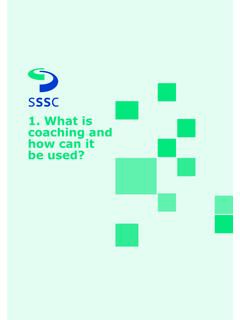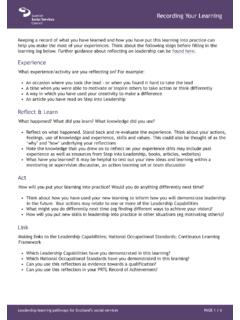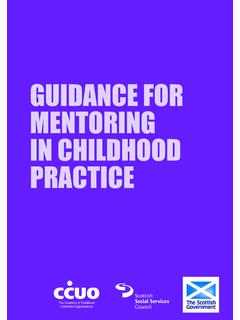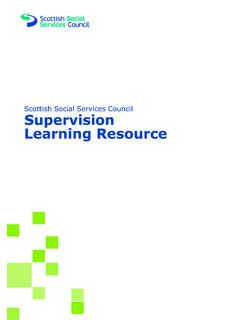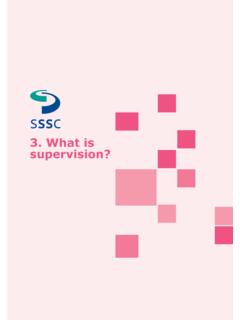Transcription of Mentoring - SSSC Leadership
1 Mentoring : Supporting and Promoting Professional Development and Learning 1 Mentoring : Supporting and Promoting Professional Development and Learning2 Mentoring : Supporting and Promoting Professional Development and LearningAcknowledgementThe Scottish Social Services Council (SSSC) wishes to thank Jennie Paul, Independent Consultant, for her help and support in developing this guidance. Mentoring : Supporting and Promoting Professional Development and Learning 3 ContentsIntroduction 5 What is peer Mentoring 6 Step into Leadership with Mentoring practice 7 Programme design, planning.
2 Management and evaluation steps 8 Who is a mentor 13 Mentor and mentee recruitment and selection criteria 14 Mentor training 15 Mentee induction 15 Mentoring models 16 Planning and managing meetings 17 ResourcesResource 1 Mentoring 24 Resource 2 Supporting change and continuous improvement 25 Resource 3 Benefits of Mentoring organisation.
3 Mentor and mentee 27 Resource 4 Mentoring policy exemplar 28 Resource 5 Exemplar Mentoring agreement 32 Resource 6 Exemplar evaluation mentors 34 Resource 7 Seven sets of behaviours of effective mentors and some hints and tips for applying the skills 35 Resource 8 Mentor role description and person specification 37 Resource 9 Differences between manager and mentor 38 Resource 10 Description of mentee responsibilities 39 Resource 11 How to make team Mentoring work 40 Resource 12 GROW A tool to guide the Mentoring conversation 41 Resource 13 Meeting log 43 Resource 14 A guide to action planning 45 Resource 15 Exemplar action plan 46 Resource 16 An introduction to OSKAR 48 Resource 17 The Mentoring lifestyle 49 Resource 18 How adults learn facilitating learning
4 50 Resource 19 Pitfalls and barriers which can cause programmes to fail 52 Resource 20 Mapping Mentoring to the Continuous Learning Framework personal capabilities 54 Good practice checklistsGood practice checklist 1 Designing Mentoring programmes 58 Good practice checklist 2 Financial/resource planning 59 Good practice checklist 3 Policy requirements 60 Good practice checklist 4 Gathering evaluation data 61 Good practice checklist 5 Monitoring data sources and questions 62 Good practice checklist 6 Mentoring meetings 63 Good practice checklist 7 A practical guide to managing, progressing and sustaining the Mentoring relationship 64 4 Mentoring : Supporting and Promoting Professional Development and LearningMentoring: Supporting and Promoting Professional Development and Learning 5 IntroductionWho is this guidance for?
5 The guidance will be of interest to social service employers, particularly managers and staff with responsibility for Leadership development and managing or developing Mentoring services or being a mentor. In order to sustain Mentoring programmes it is vital to secure formal support from leaders and other key decision makers within organisations. What is the guidance for? The guidance has been produced by the Scottish Social Services Council (SSSC) and partners. It aims to promote good practice in peer Mentoring , providing a framework designed to be adaptable to a range of contexts and is based on current research and good practice knowledge in Mentoring . The guidance is benchmarked against the standards for the Scottish Mentoring Network Quality Award as described in Mentoring : Good Practice Guide1 (Scottish Mentoring Network, 2011).
6 Organisations wishing to engage in peer Mentoring partnerships to create a sustainable, collaborative Mentoring strategy can use the may also be useful to refer to the Guidance for Mentoring in Childhood Practice2 (The Coalition of Childhood Umbrella Organisations, 2010).How should the guidance be used?You can use the guidance in a variety of ways. You can dip into it and adapt it as required. It can serve as: a guide to the creation of a framework for Mentoring - tailored to meet the needs of individual mentees and to the achievement of the goals of the programme or organisation a health check for existing Mentoring programmes a guide for on-going design, development, implementation and review an aid to managing risk. The document is in two parts, providing an overview of the key considerations for developing and sustaining a Mentoring programme a range of good practice checklists and resources which you can use for reference and adapt for your own organisation.
7 Benchmarking programmes against the good practice checklists during the design and development phase will help to minimise and manage risk. The resources provide more detailed information on a range of topics introduced within the main body of the text. 1 2 Mentoring : Supporting and Promoting Professional Development and LearningWhat is peer Mentoring ? Mentoring is a structured part of overall workforce development and planning. It is a sustained partnering relationship, with measurable outcomes, which is beneficial both for the individuals involved and for the wider organisation. As a dynamic process, it is a vehicle for the exchange of skills and the transfer of knowledge and culture. This can be unique to a profession or organisation, across and within partner agencies and organisations.
8 The focus of this guidance is on peer Mentoring as it supports individuals to develop their own self Leadership capabilities. It also promotes Leadership learning at all levels of the workforce and with people the workforce concept of the top-down approach, with senior members of staff assigned to those less senior, has been updated to a peer Mentoring approach with mentors and mentees in an equal relationship. In this updated concept of Mentoring , the responsibility lies with the mentee. Current perspectives on Mentoring have also expanded to include relationships within and across professions and organisations. There are several definitions of Mentoring , many evolving to suit the context and purpose of widely varying programmes and projects. However, all models should have the mentee firmly at the centre, with reflective practice the cornerstone.
9 Definitions include the following: The purpose of Mentoring is always to help the mentee to change something to improve their performance, to develop their Leadership qualities, to develop their partnership skills, to realise their vision, or whatever. This movement from where they are, ( here ), to where they want to be. (Mike Turner3, collected by Andrew Gibbons for the Coaching & Mentoring Network, 1999-2013) (Peer) Mentoring is a protected relationship in which learning and experimentation can occur, potential skills can be developed, and in which results can be measured in terms of competencies gained. (Audrey Collin4, collected by Andrew Gibbons for the Coaching & Mentoring Network, 1999-2013)Go to resource 1 for further definitions of Mentoring .
10 Mentoring provides opportunities to discuss work-related issues and generate possible options/solutions to some of the models, regardless of context and purpose, should have the mentee at the centre, with reflective practice the (#6)4 Ibid. (#2) Mentoring : Supporting and Promoting Professional Development and Learning 7 Why introduce peer Mentoring ?Peer Mentoring can: support and promote a culture of continuous improvement and facilitate culture change processes develop and enhance Leadership skills across the workforce highlight a range of benefits to mentors, mentees and a culture of continuous improvement and supporting changePeer Mentoring is a tool for supporting positive engagement with the continuous improvement agenda. As an organisational strategy it can promote resilience to internally and externally drive change with benefits for the participants and for organisations.
